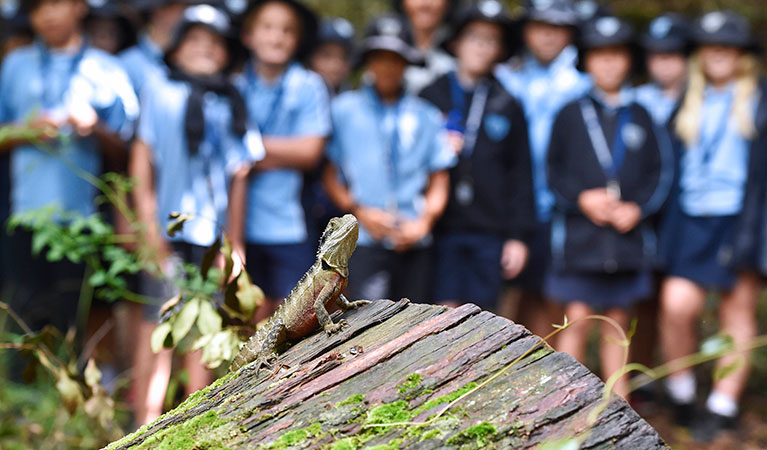School excursion
The earth's environment
Copeland Tops State Conservation Area
Overview
Did you know that over 10 per cent of NSW is a national park? That’s over 7 million hectares. This Stage 2 (Years 3-4) earth’s environment Geography excursion is delivered at Copeland Tops State Conservation Area.
Read more about The earth's environment
Students will learn about the critical role national parks play in preserving our unique native plants, animals and rich cultural heritage.
They’ll explore the significance of the environment at Copeland Tops State Conservation Area and the important interrelationships between humans and the environment. Walking along Copeland Creek, we’ll soak up the breathtaking scenery under a canopy of red cedar, grey myrtles, shatterwood and many more majestic rainforest species.
Uncover the mysterious wildlife that call this special place home, including microbats, brush-tailed possums and wompoo pigeons. You’ll discover what they eat, where they sleep and how they live in this incredibly diverse environment.
Learn about the long history of mining in the area and see where gold-hungry souls toiled in Mountain Maid gold mine – one of New South Wales’ longest-running operational gold mines.
For program outline, safety and practical information about this excursion, see info for teachers
| Stage | Stage 2 (Years 3-4) |
|---|---|
| Learning area | Geography |
| Student outcomes |
GE2-1. Examines features and characteristics of places and environments GE2-2. Describes the ways people, places and environments interact GE2-3. Examines differing perceptions about the management of places and environments GE2-4. Acquires and communicates geographical information using geographical tools for inquiry |
| Objectives |
Students will:
|
Excursion details
- When
Weekdays during school terms.
- Availability
- Guided. Available on request. Shorter length excursions are available on request.
- Duration
- 4hrs
- Grading
- Medium. Guided tour and activities on an undulating, unsealed fire trail, along a creek bed, amongst leaf litter on the forest floor and along an unsealed walking path.
- Price
-
$380 per group (includes GST). Maximum 30 students per group. For groups over 30 conditions apply.
- Accessibility
- Hard
- Meeting point
- Copeland Tops State Conservation Area carpark
- Equipment
provided - Yes
- Booking
- If you would like to organise a NPWS school excursion please get in touch with local staff or use the 'Enquire' link for the online form.
Local alerts
For the latest updates on fires, closures and other alerts in this area, see https://www.nationalparks.nsw.gov.au/education/stage-2-geography-earths-environment-copeland-tops/local-alerts
Operated by
- School excursion inquiries - Newcastle Hunter
- 02 4927 3267
- discovery.newcastlehunter@environment.nsw.gov.au
- Hunter Wetland Centre, Sandgate Road, Shortland NSW
Park info
- in Copeland Tops State Conservation Area in the North Coast region
Copeland Tops State Conservation Area is always open but may have to close at times due to poor weather or fire danger.
Info for teachers
All the practical information you need to know about The earth's environment.

